Golden Opportunity: How Rising Gold Prices Can Benefit Emerging Market Sovereigns and Corporates

Sam McDonald
Sovereign Analyst, Global Sovereign and Economics

Devin Stewart
Credit Analyst, Emerging Markets Fixed Income

The price of gold is hovering near historic highs – a boon for gold-producing countries, as well as investors. Major gold-producing emerging market (EM) nations such as Uzbekistan, Kazakhstan, and South Africa benefit from high gold prices but by differing degrees. Varying levels of gold export exposure, sectoral significance, royalty structures, the role of state-owned enterprises, and investment potential all shape how much each country stands to gain from elevated gold prices.
For corporates, elevated gold prices support free cash flows, but differences in objectives around mergers and acquisitions (M&A), capital expenditures, maximizing shareholder returns, or deleveraging mean idiosyncratic differences for credit quality.
Macro backdrop: Why are gold prices currently high?
Gold prices have rallied persistently since the third quarter of 2023, rising from around $2,000/oz. to over $3,300/oz. in June 2025, with a significant amount of the legwork taking place since 1 January. There are several key reasons for why gold has performed so well over this period. First, gold is considered a safe-haven asset during periods of economic or geopolitical uncertainty. With the backdrop of a trade war and rising conflict risk – as seen in the Middle East – gold becomes an attractive asset for investors. The trade war has also triggered concerns about a US growth slowdown and rising near-term inflation as investors seek to hedge against these risks.
Gold Spot Prices Have Been Rising for Years
$/ounce
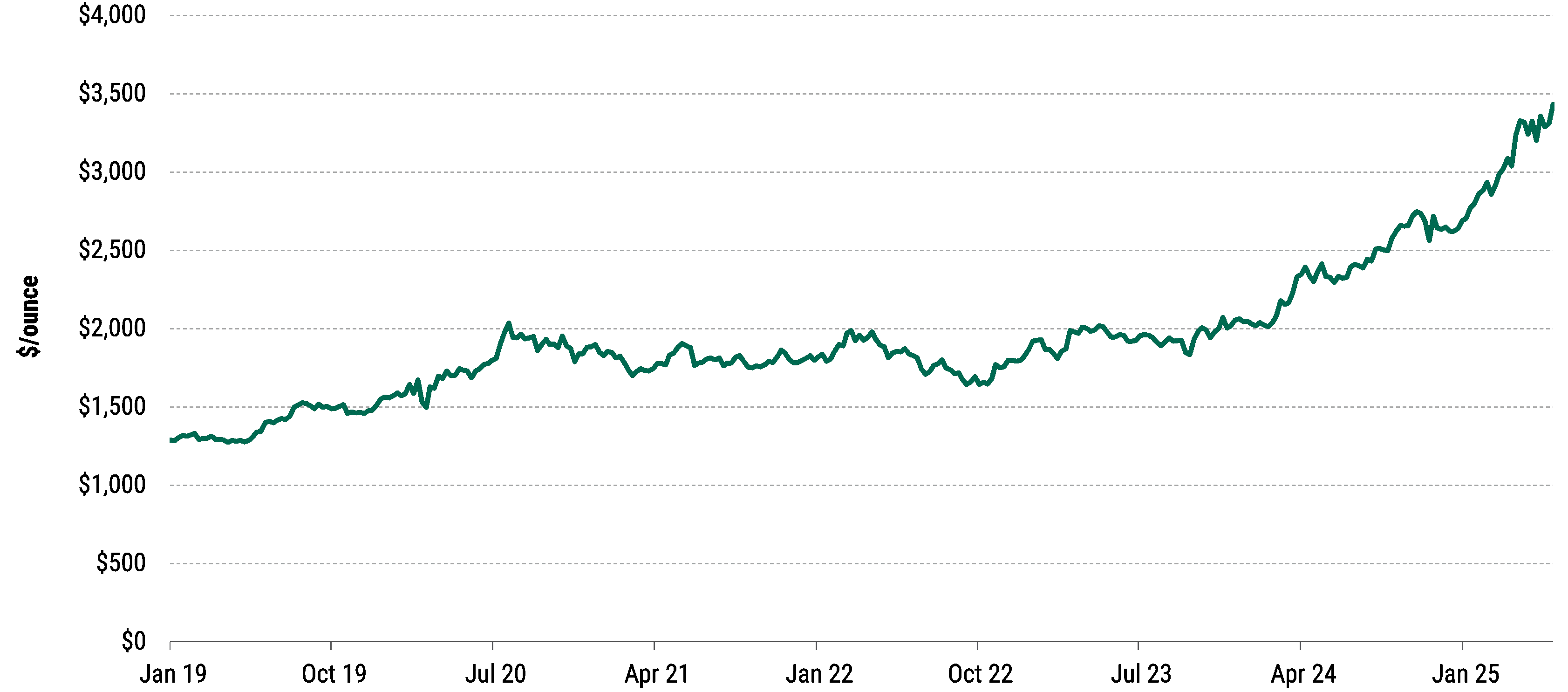
Source: Macrobond as of 19 June 2025.
This has also extended to many central banks, which are buying more gold as they seek to diversify away from the dollar and US Treasuries due to risks around US government policy. According to the World Gold Council, approximately 20% of total gold demand derives from central banks – almost double their historical average share. April Gold ETF flows saw the largest inflow since March 2022, adding $11 billion, with Asia inflows alone totalling $7.3 billion1 as concerns over Trump’s trade policies with China amplified worries over weakening growth and risk-asset valuations.
What proportion of total reserves (FX and gold) do you think will be denominated in gold five years from now?
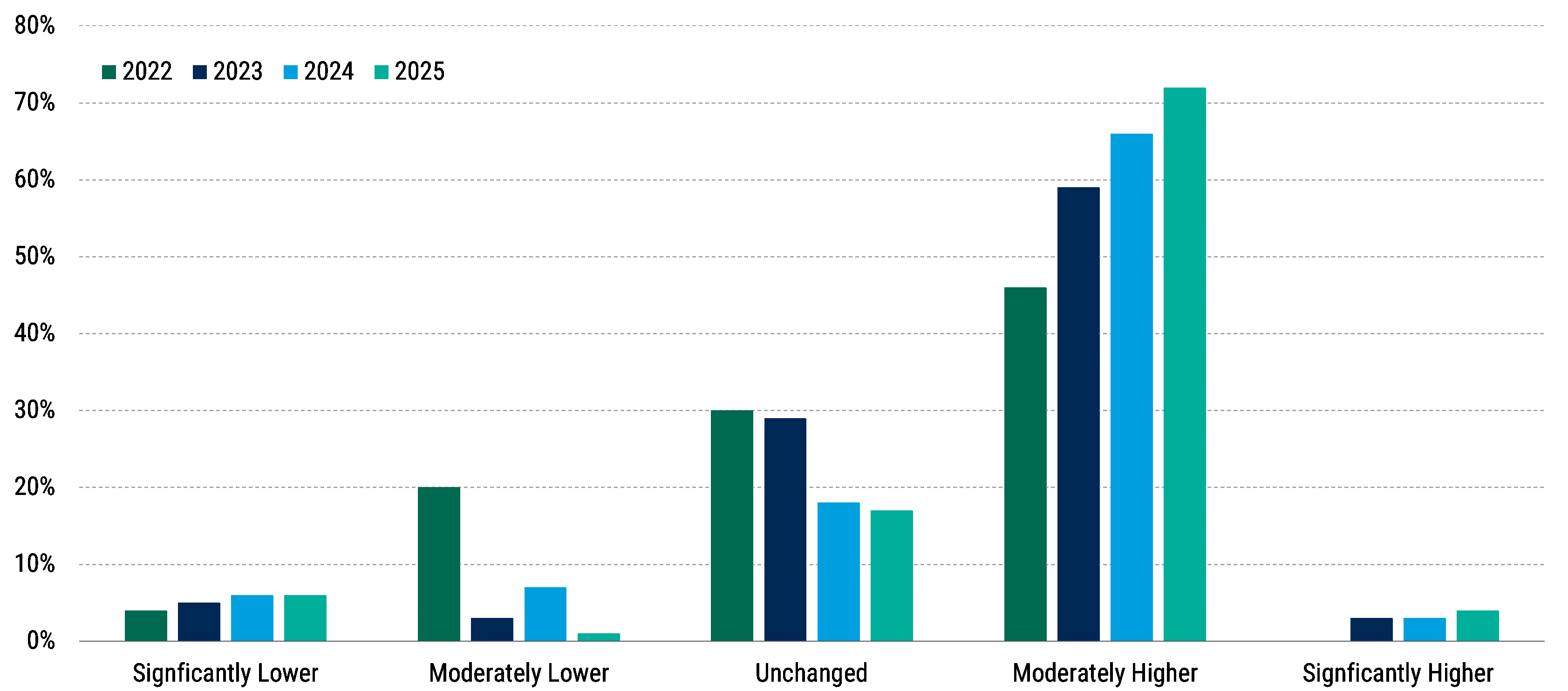
Source: World Gold Council, Central Bank Gold Reserves Survey 2025 – central banks as survey respondents (as of 17 June 2025): https://www.gold.org/goldhub/research/central-bank-gold-reserves-survey-2025/perspectives-on-gold-reserves
Despite signs of US trade de-escalation with China and the signing of a deal with the UK, gold prices are still expected to remain elevated due to continued geopolitical risks in Ukraine and the Middle East, as well as the ongoing portfolio rebalancing away from the US.
Benefit to EMs: a terms-of-trade windfall
Terms of trade measures the relative level of a country’s export prices to its import prices. When the price of a commodity, such as gold, in a commodity-producing country rises, the trade balance will improve, all else being equal. This supports current account balances and the currency and helps to reduce external vulnerabilities for a sovereign.
Uzbekistan is likely to benefit most from this shift – gold exports now account for over 40% of its total export revenues. Total exports have grown by over $20 billion since August 2023, with higher gold exports accounting for 70% of the rise. The improved trade balance in 2024 was a key driver of the decline in Uzbekistan’s current account deficit to 5% of GDP, down from 6.2% in 2023, along with stronger remittance inflows. Assuming gold prices remain near historical highs, we expect these trends to continue. Uzbekistan was the top gold seller in first-quarter 2025, with the Central Bank of Uzbekistan net selling 15 tons.
These trends are also likely to induce further investment in the gold-producing countries. For example, Solidcore, Kazakhstan’s second-largest gold miner, is aiming to produce 15 tons of gold per annum, with a $1 billion investment over the next two years.
Uzbekistan’s Gold Exports Have Risen
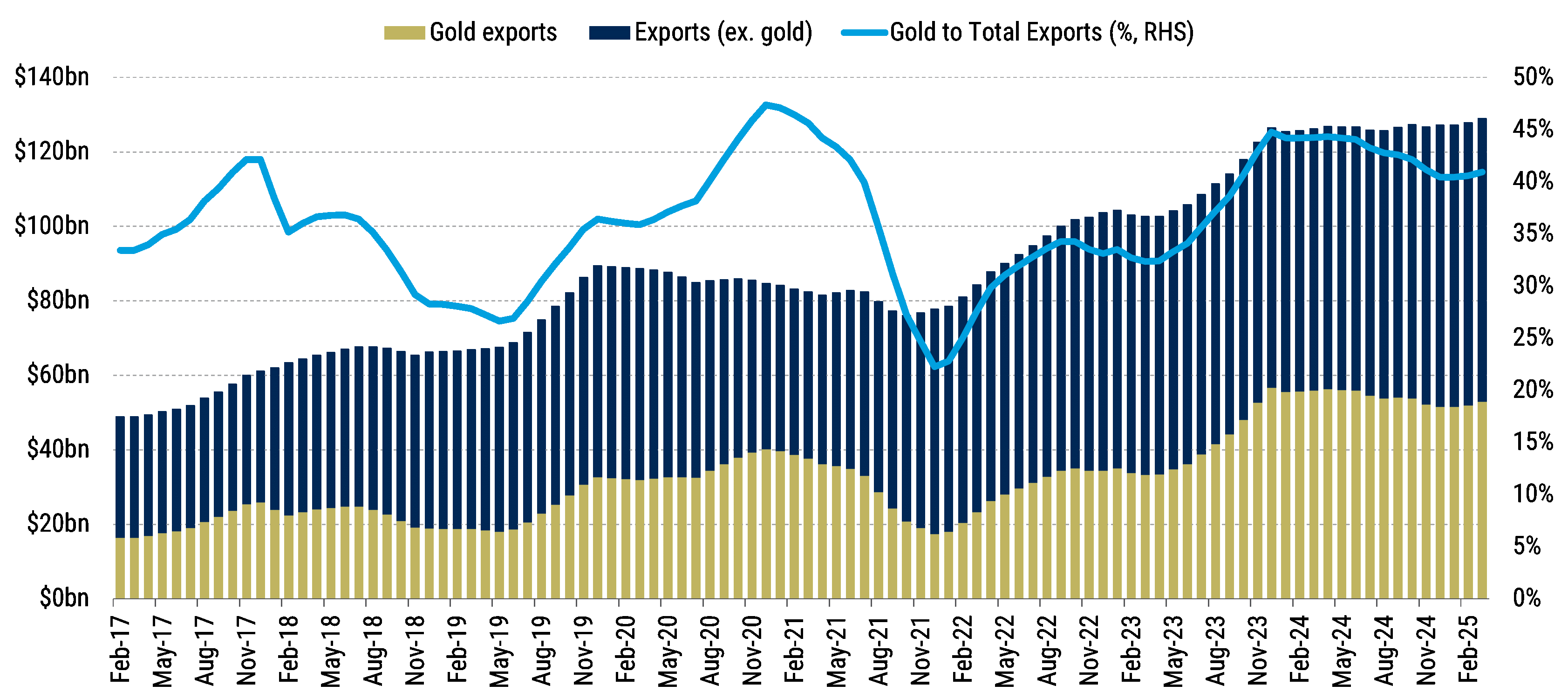
Source: Macrobond as of 20 May 2025.
South Africa’s terms of trade have also benefited from the recent gold price trend. Gold exports contributed 8% of South Africa’s total exports in 2024. Gold exports were up approximately 57% year-over-year (y/y) in March on a three-month average basis – responsible for 43% of the growth in South Africa’s exports over the past year. This is despite mining output falling 2.8% y/y due to the country’s unreliable power supply, high input costs, and logistical constraints.
Kazakhstan is also one of the largest gold producers, but the relative benefit to its terms of trade is significantly lower than for Uzbekistan. Gold exports amounted to just 0.5% of Kazakhstan’s total export share in 2024, with oil-related revenues being the main export product (57%), thus implying that the relative contribution from higher gold prices is materially smaller. However, with oil prices having moved lower for the first half of this year, albeit having moved temporarily higher due to conflict escalation, elevated gold prices do provide some mitigation for Kazakhstan’s exports, which were down 7.2% y/y in March on a three-month average basis.
FX reserves and external buffers
Elevated gold prices also benefit EM sovereigns via revaluation effects of reserve holdings. Most EM central banks follow the IMF’s guidelines and classify gold on fair-value accounting or mark-to-market basis. Therefore, if gold prices rise in a given month, and assuming a stable exchange rate and no newly produced gold added to reserves, then functionally total reserves (which include gold) will rise. Additionally, the gold-producing countries can add to their holdings by weight. For example, the National Bank of Kazakhstan purchases gold from domestic producers in tenge and then sterilizes the purchases afterwards with FX sales. Given that gold-producing countries tend to have higher shares of gold reserves relative to total reserves, these countries will see a disproportionate benefit from higher gold prices.
The key benefit to EM sovereigns from these factors is that it will create larger external buffers. From a credit rating perspective, high external buffers reduce the risk of default on hard currency debt. Furthermore, they reduce the risk of balance-of-payment crises and help to provide ammunition for central banks to preserve financial and economic stability, where prudent to do so – normally in periods of shocks. There has been a clear upward trend in total reserves in many gold-producing EM countries, but also in those that hold a higher share of total reserves in gold due to the mark-to-market effect. For example, Uzbekistan’s total reserves have increased from $36.7 billion in February 2024 to $49.2 billion in April 2025, driven almost entirely by its gold holdings, which account for 76% of total reserves.
Kazakhstan has seen a similar trend, with total reserves increasing to $111 billion from $96 billion, while gold reserves increased from $20 billion to $30.8 billion over the same period. However, gold is a lower proportion of Kazakhstan’s total FX reserves compared to Uzbekistan, at 28% in April 2025, but up from 20% in February 2024. Kazakhstan’s main contributor to total reserves stems from its National Oil Fund assets. Furthermore, the improved terms-of-trade effect stemming from higher gold prices can help improve trade balances and therefore provide support to the current account balance. This has a secondary added effect of helping EM sovereigns to further build FX reserves, creating something of a short-term virtuous cycle. However, over the long term, risks around “Dutch Disease” can undermine a country’s manufacturing base if currency appreciation from the gold exports reduces competitiveness in other sectors, leading to an eventual deterioration in the underlying trade balance.
Gold Is the Biggest Contributor to Uzbekistan’s Total Reserves
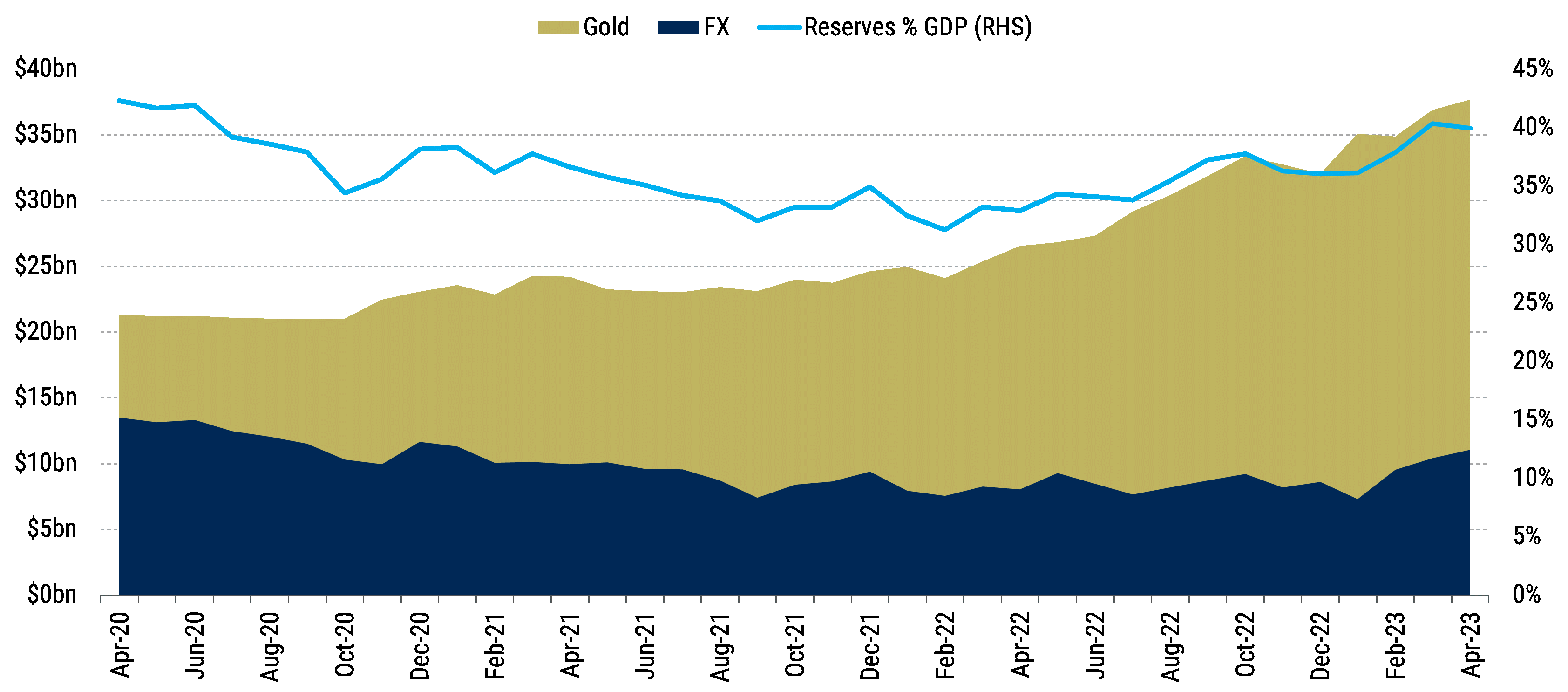
Source: Central Bank of Uzbekistan as of 12 May 2025.
Oil Dominates Kazakhstan’s Total Reserves, But Gold Is Growing
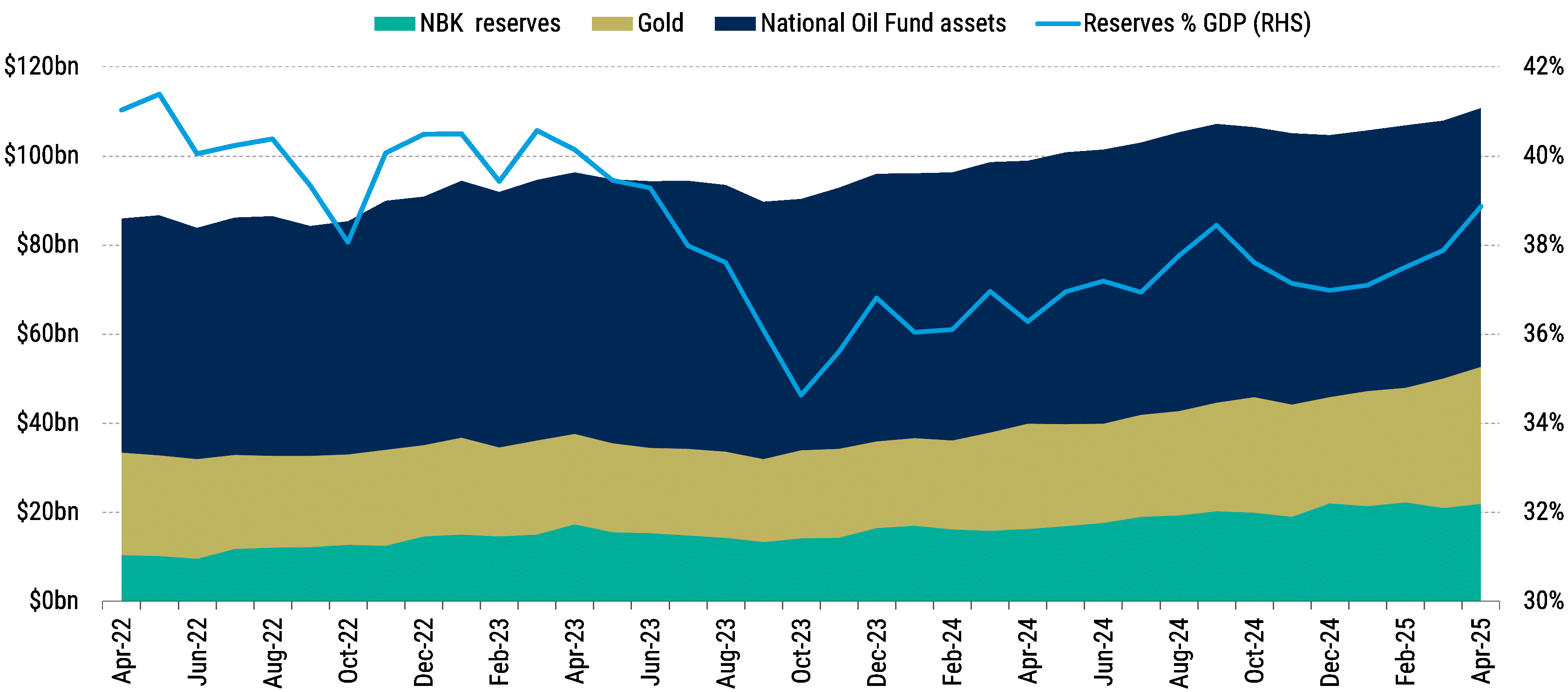
Source: National Bank of Kazakhstan as of 14 May 2025.
Gold revenue and sovereign finances
Another benefit to sovereign credit profiles from elevated gold prices is via royalty transfers, dividends, and mining duties to the government. Each country has a different approach depending on its respective tax codes, the share of state-owned enterprises in the sector, and the size of the mining industry relative to the economy. Uzbekistan has a 7%[DS1] tax on subsoil use for gold. Kazakhstan currently has a mineral extraction tax of 50% on gold but aims to replace this with a royalty system in its 2026 tax code. The movement to royalties is to increase the number of foreign investors in the mining industry due to the transparency and familiarity of the system. Countries like South Africa already use a royalty framework, where the rate depends on profitability of the mining operation and whether minerals are refined or unrefined.
To illustrate, Uzbekistan sees material uplift to its fiscal revenues from the gold sector – the state-owned gold producer Navoi Mining and Metallurgical Company is estimated to have contributed approximately 20% of the government’s budget revenues in 2024, up from 16.7% in 2023. Uzbekistan’s consolidated budget deficit declined to 3.3% of GDP in 2024 from 5% in 2023, driven by a combination of 5% growth in budget revenues and a reduction in gas subsidies on the expenditure side. For countries like Kazakhstan and South Africa, the impact of high gold prices on fiscal contributions will be lower because the gold segment is a smaller proportion of the overall sector and therefore the economy. For example, in South Africa, mining revenues from gold amount to only about 18% of total domestic mining revenues, with coal (25%) and platinum group metals (22%) being larger contributors.
FX-denominated revenues from gold also ease sovereign funding pressures, potentially lowering hard currency issuance. This, along with higher external buffers, export-led growth, and support for fiscal receipts, are positive drivers for credit rating outlooks and should support spread compression for the major gold-producing EM sovereigns.
Gold miners and the corporate impact
Mining companies have also benefited from higher gold prices, giving them significant amounts of free cash flow. While the benefit to gold mining companies is universal, this newfound wealth is where the similarities largely stop.
Some companies, like the Uzbekistan government-owned Navoi Mining and Metallurgy Company, have focused on maximizing shareholder returns. Despite free cash flow rising 34% from 2023 to 2024, the dividend rose 44%, leaving the actual payout ratio at 110% of cash flow for full-year 2024 and requiring the company to issue debt to cover the shortfall.
Other companies have focused on M&A or expansionary capex, looking to grow their businesses. Goldfields has announced two major acquisitions in the past six months, with its acquisition of Gold Road Resources for A$3.7 billion closing in the second half of 2025 and Osisko Mining for C$2.2 billion closing in fourth-quarter 2024. While Goldfields generated roughly $800 million in free cash flow before M&A in 2024 and look well positioned to generate even more in 2025, these cash flows have been entirely used and additional debt financing taken to increase the asset base of the company.
Still other companies have been more conservative, choosing to stockpile the newfound wealth for future projects or to deleverage. While AngloGold did acquire Centamin for $2.5 billion, it did so with almost entirely equity, allowing excess cash flow to be used for other purposes. AngloGold also raised its dividend by 128%, but the payout ratio only rose to 29% of free cash flow, allowing the company to raise cash and deleverage. Endeavour Mining also looks to use the current cash flows to position itself to take on its major Assafou project in Ivory Coast, which could begin construction in late 2026 and cost $734 million in capital expenditures to make operational.
While overall the sector is in a robust place, it has faced some headwinds as costs have risen over the past several years. This has been driven by a combination of higher energy costs, higher labor costs, and higher royalties as gold prices have risen. Energy costs have become less of a headwind, with some moderation after the volatility caused by Covid and the Ukraine-Russia conflict. Labor costs have also started to slow, with wage growth moderating as inflation comes down. While it’s unlikely that all-in sustaining costs will come down, they are likely to stabilize at current levels.
Tailwinds for EM sovereigns and corporates
Higher gold prices offer EM sovereigns tailwinds from improved terms of trade and export growth, enhanced external buffers, and higher fiscal revenues. Yet EM sovereigns should still balance diversification risks in their FX reserves; a sudden reversal in the gold price trend would lead to a deterioration in external buffers. Uzbekistan has benefited significantly from the gold price trend, but gold now accounts for three-quarters of its total reserves, highlighting the diversification risk for some.
Similarly, while sovereigns may benefit from windfall receipts from gold exports, governments should be careful not to increase structural expenditures, such as on untargeted social measures, on account of uncertain future gold revenue streams. For corporates, differences in strategy regarding the use of higher free cash flows will ultimately determine how much the companies benefit from the gold price windfall from a credit perspective.
With the recent hostilities between Israel and Iran (and the entrance of the US into the fray), combined with the possibility that trade tensions return, the demand for gold is expected to remain firm in the near term. With central banks indicating intentions to further increase gold holdings, we expect gold prices to remain supportive for EM fundamentals.
From a credit rating perspective, higher gold prices are already being reflected in some of the outlooks for EM sovereigns. For example, S&P highlighted elevated gold prices as one of the drivers for the change to a positive outlook for Uzbekistan in May. We expect this factor to be relevant to other sovereigns going forward.
Disclosure
Investing involves risk, including possible loss of principal. The information presented herein is for illustrative purposes only and should not be considered reflective of any particular security, strategy, or investment product. It represents a general assessment of the markets at a specific time and is not a guarantee of future performance results or market movement. This material does not constitute investment, financial, legal, tax, or other advice; investment research or a product of any research department; an offer to sell, or the solicitation of an offer to purchase any security or interest in a fund; or a recommendation for any investment product or strategy. PineBridge Investments is not soliciting or recommending any action based on information in this document. Any opinions, projections, or forward-looking statements expressed herein are solely those of the author, may differ from the views or opinions expressed by other areas of PineBridge Investments, and are only for general informational purposes as of the date indicated. Views may be based on third-party data that has not been independently verified. PineBridge Investments does not approve of or endorse any republication of this material. You are solely responsible for deciding whether any investment product or strategy is appropriate for you based upon your investment goals, financial situation and tolerance for risk.



